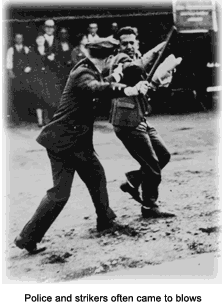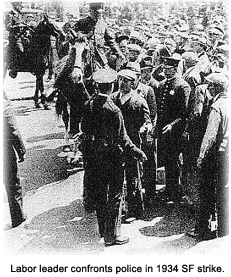On May 9, 1934, International Labor Association (ILA) leaders called a strike of all dockworkers on the West Coast, who were joined a few days later by seamen and teamsters — effectively halting all shipping from San Diego, California to Seattle, Washington for more than two months. San Francisco became the scene of the strike’s most dramatic and widely known incidents, luridly described in one headline as, "War in San Francisco!"
 San Francisco indeed saw violent industrial strife. Gruesome confrontations took place in the streets, with police gunfire wounding some unarmed strikers.
By order of the General Strike Committee, saloons and liquor stores were closed, but 19 restaurants were allowed to remain open. Scribbled signs and placards in the windows of many small businesses read: "Closed Till The Boys Win," or "We're With You Fellows... Stick It Out," or "Closed Till The Longshoremen Get Their Hiring Hall," or "Closed. ILA Symphathizer."
An eerie quiet settled over the acres of buildings affected by the strike. For all practical purposes, not a wheel moved nor a lever budged. The clatter of commercial activity gave way to a whisper of voices on the docks.
Highways leading out of the city bore a continuous stream of expensive cars carrying well-to-do refugees to distant sanctuaries.
The media aggravate tension
With shared motives, newspapers and commercial radio of 1934 San Francisco "hammed it up." Truth evolved into distorted and invented daily events — colored in propaganda — worsening the violence that actually existed.
They described the event as a "Bolshevik revolution," fabricating visions of agitated packs of wolves, torches in hand, prowling through the city streets.
Pedestrians bought copies of newspapers whose headlines trumpeted mayhem of apocalyptic dimensions. Those misleading papers declared that the city was in control of Communists who were threatening bloodshed and ruin. In residential sections, some malinformed citizens were frightened out of their wits. Many of them barricaded their doors and jittered in anticipation of chaos.
Every few hours, the newspapers issued blazing extras announcing, "Big Strike Broken!" The strike was not over of course, and there was no reason to think that it was. Those extras served to create restlessness among the strikers and general public — and sell papers. Citizens of San Francisco were cleaning out newspaper stands in hopes of finding an end to the madness.
Bloody Thursday
On the morning of July 5, 1934, 1,000 police officers attempted to clear picketers from the waterfront so that strikebreakers could do the work of the striking dockworkers. In the ensuing riot, two strikers were killed and 64 people were injured.
Gangs of vigilantes roamed the city, smashing halls and homes where Communists were known or supposed to gather. More than 450 persons were packed into a city jail built to accommodate 150.
In another confrontation, two strikers were killed, with 109 people wounded by the San Francisco Police. A mass funeral march of 12,000 men behind the victims' coffins four days later, and the general strike that followed, effectively shut down both San Francisco and Oakland.
The governor calls in the troops
California Governor Frank Merriam finally requested federal intervention, which initially deployed youngsters from the local National Guard unit.
Along the Embarcadero and in front of the National Guard Armory, anxious teenaged soldiers wearing steel helmets and awkwardly fitting khaki uniforms paced up and down, fingering heavy automatic rifles.
Soldiers on the waterfront were later augmented by 390 additional guardsmen, including 250 men of the 184th Infantry from Santa Rosa, Petaluma and Napa, and 140 men of the same regiment from San Jose. Those additions brought the total militia command on duty there to nearly 2400.
The men were briefed with direct orders: "Shoot to kill" in the event of an attack; if orders were not followed, they would be subjected to a court martial. Young soldiers were ordered to fire shots over the heads of strikers armed with bricks; other attempts to break up the massive crowd resulted in more ruthless "bullying and skull cracking" by the guard.
San Francisco indeed saw violent industrial strife. Gruesome confrontations took place in the streets, with police gunfire wounding some unarmed strikers.
By order of the General Strike Committee, saloons and liquor stores were closed, but 19 restaurants were allowed to remain open. Scribbled signs and placards in the windows of many small businesses read: "Closed Till The Boys Win," or "We're With You Fellows... Stick It Out," or "Closed Till The Longshoremen Get Their Hiring Hall," or "Closed. ILA Symphathizer."
An eerie quiet settled over the acres of buildings affected by the strike. For all practical purposes, not a wheel moved nor a lever budged. The clatter of commercial activity gave way to a whisper of voices on the docks.
Highways leading out of the city bore a continuous stream of expensive cars carrying well-to-do refugees to distant sanctuaries.
The media aggravate tension
With shared motives, newspapers and commercial radio of 1934 San Francisco "hammed it up." Truth evolved into distorted and invented daily events — colored in propaganda — worsening the violence that actually existed.
They described the event as a "Bolshevik revolution," fabricating visions of agitated packs of wolves, torches in hand, prowling through the city streets.
Pedestrians bought copies of newspapers whose headlines trumpeted mayhem of apocalyptic dimensions. Those misleading papers declared that the city was in control of Communists who were threatening bloodshed and ruin. In residential sections, some malinformed citizens were frightened out of their wits. Many of them barricaded their doors and jittered in anticipation of chaos.
Every few hours, the newspapers issued blazing extras announcing, "Big Strike Broken!" The strike was not over of course, and there was no reason to think that it was. Those extras served to create restlessness among the strikers and general public — and sell papers. Citizens of San Francisco were cleaning out newspaper stands in hopes of finding an end to the madness.
Bloody Thursday
On the morning of July 5, 1934, 1,000 police officers attempted to clear picketers from the waterfront so that strikebreakers could do the work of the striking dockworkers. In the ensuing riot, two strikers were killed and 64 people were injured.
Gangs of vigilantes roamed the city, smashing halls and homes where Communists were known or supposed to gather. More than 450 persons were packed into a city jail built to accommodate 150.
In another confrontation, two strikers were killed, with 109 people wounded by the San Francisco Police. A mass funeral march of 12,000 men behind the victims' coffins four days later, and the general strike that followed, effectively shut down both San Francisco and Oakland.
The governor calls in the troops
California Governor Frank Merriam finally requested federal intervention, which initially deployed youngsters from the local National Guard unit.
Along the Embarcadero and in front of the National Guard Armory, anxious teenaged soldiers wearing steel helmets and awkwardly fitting khaki uniforms paced up and down, fingering heavy automatic rifles.
Soldiers on the waterfront were later augmented by 390 additional guardsmen, including 250 men of the 184th Infantry from Santa Rosa, Petaluma and Napa, and 140 men of the same regiment from San Jose. Those additions brought the total militia command on duty there to nearly 2400.
The men were briefed with direct orders: "Shoot to kill" in the event of an attack; if orders were not followed, they would be subjected to a court martial. Young soldiers were ordered to fire shots over the heads of strikers armed with bricks; other attempts to break up the massive crowd resulted in more ruthless "bullying and skull cracking" by the guard.
 A once economically diverse city was now scattered by bayonets, and destitution festered. Screaming ambulances rushed the wounded to over-crowded hospitals. The smell of tear and nausea gas lingered in much of the business district. Stores and shops also were wrecked. Pedestrians ran for shelter from ricocheting bullets slamming into window glass.
The general strike
In July 1934, the ILA responded to the events of "Bloody Thursday," and the federal government's involvement, by calling for a general strike — asking members of other unions to go onto the picket line in support of the dockworkers. The laboring population laid down its tools in a citywide general strike.
Virtually every union in San Francisco and Alameda county joined in the strike, which began on July 16 and continued for four days. The widening strike alienated public opinion, but also demonstrated the strength of united labor.
The unions settle
The original waterfront strike was resolved when federal arbitrators granted the ILA most of its demands. In the aftermath, a letter was released by Edward Vandeleur, president, and George Kidwell, secretary of the General Strike Committee, on July 15, 1934:
A once economically diverse city was now scattered by bayonets, and destitution festered. Screaming ambulances rushed the wounded to over-crowded hospitals. The smell of tear and nausea gas lingered in much of the business district. Stores and shops also were wrecked. Pedestrians ran for shelter from ricocheting bullets slamming into window glass.
The general strike
In July 1934, the ILA responded to the events of "Bloody Thursday," and the federal government's involvement, by calling for a general strike — asking members of other unions to go onto the picket line in support of the dockworkers. The laboring population laid down its tools in a citywide general strike.
Virtually every union in San Francisco and Alameda county joined in the strike, which began on July 16 and continued for four days. The widening strike alienated public opinion, but also demonstrated the strength of united labor.
The unions settle
The original waterfront strike was resolved when federal arbitrators granted the ILA most of its demands. In the aftermath, a letter was released by Edward Vandeleur, president, and George Kidwell, secretary of the General Strike Committee, on July 15, 1934:
"What are the ends to be attained in this strike movement? Correction of wages, hours or working conditions? Only in specific cases and in reference to certain definite union groups. The overwhelming cause which has forced San Francisco's men and women to leave their work is the unified and almost overwhelming attack of certain employer groups upon labor's rights to organize in their own unions and to bargain collectively through representatives of their own choosing. Now this placed in the hands of business leaders and industry owners a vast new power which, unchecked, in irresponsible hands, would have resulted in an overwhelming and unbearable penalty against the nation as a whole for the advantage of the few, to consumers in prices pyramided under monopoly, to labor in wage levels crushed down by unified monopolistic action. To prevent top-heavy development, the government has planned a system of checks and balances in the new industrial scheme: protection of consumers through federal institutions in their behalf, and protection of the rights of labor by actively supporting the workers' rights to organize into trade unions to bargain with united employers. Thus the National Industrial Recovery Act, the legal statutes of the United States under which practically all employers of America now operate, affirms the rights of unionization in words which no intelligent and fair-minded person can mistake."